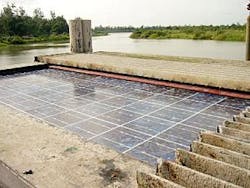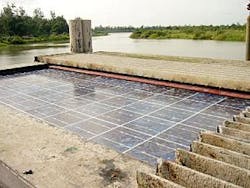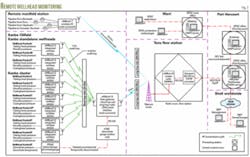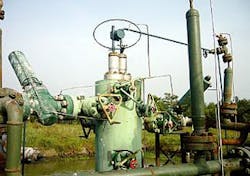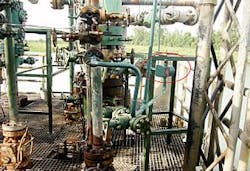Low power, two-way wireless communication devices, powered by batteries, proved effective for long-range monitoring of producing wells and facilities in the dense jungle and swamps of the Niger Delta in Nigeria.
The impetus for Shell Petroleum Development Co. of Nigeria (SPDC) to develop and deploy this technology in Nigeria came from a Shell GameChanger organization workshop, held in Abuja, Nigeria, in 2003 that discussed SPDC technology needs for the next decade.
The GameChanger group is a Shell organization focused on bringing to Shell operating units advanced technology from various industry, academic, and research and development organizations.
The workshop made clear that the inability to monitor remote assets (wells, pipelines, remote flow stations) degraded operations through the loss of production from well shutdowns and delayed intervention. Problems included:
• Slow manual access of data from wellheads and downhole.
• Delayed detection of pipeline problems.
• Ineffective reservoir management and optimization because of the need to obtain data primarily from conventional and non-timely well tests.
The workshop estimated, therefore, that microwireless sensors for monitoring wells and remote manifold stations could at least increase production by 1%. The technology that could function in Nigeria’s environment, however, did not exist.
SPDC operates more than 1,000 producing wells onshore that produce more than 900,000 bo/d.
Technology impediments
SPDC previously had tried several monitoring technologies without much success. Conventional automation and remote monitoring systems that deployed wireless (radio and satellite) communication had the following limits (Fig. 1):
• Requirement for solar power panels that were constantly stolen or sabotaged.
• High cost of the technology with too many components, such as remote terminal units (RTUs), radios, solar panels, antennas, and cabling. This technology at remote sites was bulky and attracted attention for potential theft.
At the conclusion of the workshop, several engineering and business managers outlined the critical requirements for the new-generation technology of microwireless sensors. Features of these units included:
• Small enough so that they attracted less attention.
• Low power and battery operated, without solar panels.
• Long-range wireless communication capabilities, greater than 4-5 miles in a dense jungle.
• Low-cost, almost at a price that would make them disposable and maintenance free.
Microwireless sensors technology
The GameChanger group and SPDC joined with vMonitor Inc. to develop these microwireless units with integrated pressure, temperature, or flow sensors. These micro devices would have the ability to integrate multiple sensors and third-party devices, such as wells with surface data acquisition from downhole gauges.
A feasibility study and an extensive industry review of available technology and options made it clear that the major challenge vMonitor faced was how to design low power, two-way wireless communication devices that can run on batteries and at the same time transmit over a long range, greater than current industry norm, in a dense jungle.
The transmission distance for existing microwireless sensor technology running on batteries was limited to less than 3,000 ft with a clear line of sight. SPDC needed devices that would function in a thick jungle and in some cases for 15-20 km transmission distances.
As a result, an important requirement was that the new units should have multihopping communication capabilities and a means to work in a cluster and mesh architecture.
The decision to use radio technology instead of satellite or cellular was straight forward. Satellite communication was too costly because of the need for frequent data monitoring, which for many wellsites was every 5-10 min. Cellular infrastructure was nonexistent in most remote areas of the fields.
After nearly 1 year of research and development, vMonitor designed a low-power microwireless sensor that uses spread-spectrum radio communication called vMBusX-S (Fig. 2). These devices can fit inside an enclosure of about 10 cm in diameter.
The unit can be coupled with low-power pressure, temperature, differential pressure, or tank-level sensors. The vMBus also receives input from up to three sensors and can interface to a third-party device (such as a downhole gauge) through a serial interface.
These microwireless sensor units can operate within a cluster and mesh architecture, and the study determined that the optimal architecture combines a cluster architecture with multihopping capabilities.
Micro sensors at each remote location, such as wells, would communicate to a remote gateway. The remote gateway then can communicate with many units (theoretically with hundreds).
The remote gateways would have solar power and long-range radios.
Pilot test
The pilot test in the Kanbo field in Warri provided a way to assess the typical challenges and difficulties that wireless technology must overcome. Fig. 3 shows details of the installation.
The pilot included vMBus wireless units on eight wells. Six of these wells were in one cluster and the other two wells were standalone wells.
The six-well cluster communicated with a gateway that was about 1 km away with 2.4-Ghz frequency radios.
The remote gateway collects the data from all eight wells and transmits the data via a long-hop radio, up to a 6-km range, back to the main flow station where a master gateway was installed on the communication tower.
The remote gateways have long-range 900-Mhz radios.
The master gateway feeds the data into a vMonitor web-based software, TOTALACCESS, that displays the data on the SPDC’s intranet and provides an OLE (object linking and embedding) for process control (OPC) link to the SPDC central data historian, OSI PI.
On each well, vMBus handles data measurements for the tubinghead, flowline, and casinghead pressures (Fig. 4).
Voltage sensors (0-5,000 psi) were used for the pressure sensors. The vMBus wireless units supply 12 v to power the sensors that take measurements every 10 min and transmit the data to the remote gateway.
SPDC commissioned the wireless system in January 2005.
The pilot test demonstrated that low power, battery-operated wireless sensors can communicate over a long range across a thick swamp and jungle.
These wireless devices are small enough so that when installed they are barely noticeable on the wells (Figs. 4 and 5).
The goals for the technology cost set at the original Abuja workshop were nearly met during this first development stage.
Personnel can view the transmitted data from anywhere on the SPDC intranet and even on the Shell worldwide network with the proper security access. TOTALACCESS provides web-based visual screens for monitoring each well’s critical data.
This installation is the first-phase of a two-phase project. The second phase will deploy additional vMBus wireless units on another cluster, further demonstrating the ability for multiple hops communication and two-way communication for remote control applications.
Technology benefits
Remote well surveillance with microwireless sensor technology will significantly affect SPDC’s operation, production, safety, and long-term reservoir life.
Early testing results show that the technology has provided more than a 1% production increase. For example production for eight wells at the Soku gas plant increased to 110 MMscfd/well from 90 MMscfd/well after installation of sensors and wellhead data transmission. This increase yields an extra $29 million/year of revenue at a gas price of $0.50/Mscf.
Also this increase may avoid the need to drill new wells, which in this area cost about $11 million/well to drill.
The savings from capital and operating costs from these microwireless sensors indicate that the investment will payout in a matter of months, if not weeks.
The numerous benefits of this technology to SPDC include:
• Proactive (by exception) intervention, better hydrocarbon accounting, and control of production deferments.
• Improved reservoir management, well production optimization, and prolonging life of reservoirs.
• Enhanced well integrity and health, safety, and environment performance through availability of continuous real-time well parameter monitoring, ability to avert disasters, and reduced repairs, workovers, and drilling of new wells.
• Reduced need for operator intervention at well sites, which lessens need for field staff travel.
• Enablement of smart fields development. Wireless bi-directional communication will provide timely well flow data and allow downhole valve control that opens and closes wells remotely.
• Remote and real-time well monitoring will save money being spent on bottomhole pressure surveys. These cost tens of thousands of dollars per well each year. ✦
The authors
Toyin Fasasi is a control and automation engineer for Shell Petroleum Development Co. of Nigeria Ltd. (SPDC), in Port Harcourt. He has worked as a field operations engineer, control-aided-automation (CAO) systems engineer, and currently is the CAO applications support team leader. Fasasi previously was a field services and project engineer for an engineering firm in Nigeria.
Don Maynard works for the Shell GameChanger Group in Houston. He previously worked for Shell Technology Ventures Inc. Prior to Shell he spent 24 years in refining and petrochemicals, holding senior positions with responsibility in process economics, economic evaluation, strategic planning, sales, purchasing, and product-business management. Maynard has a BS in chemical engineering from the University of Pennsylvania.
Hatem Nasr is a cofounder of vMonitor Inc, Houston. Prior to vMonitor, he was the technology director at Baker Hughes Inc. and worked for several years at the Honeywell Technology Center.
Rajesh Patwari is a senior systems engineer at vMonitor. He has managed several vMonitor projects involving remote monitoring systems in various countries, including Oman, Kuwait, and Nigeria. Prior to joining vMonitor, he worked in automation and control in Saudi Arabia. Patwari has an MS in electrical and computer engineering from the University of Massachusetts, Amherst.
Srikanth Mashetti is a systems engineer at vMonitor. He was involved in the vMonitor system design and deployment in Nigeria. Prior to vMonitor, he worked for Solutia Inc. in Massachusetts. Mashetti has a MS in electrical and computer engineering from the University of Massachusetts, Amherst, and a BE from the Indian Institute of Technology.
